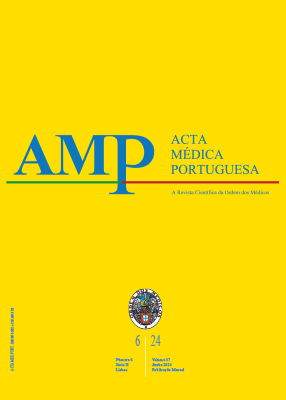Guidelines for the Diagnosis and Treatment of Uncomplicated (Non-Lymphogranuloma Venereum) Chlamydia trachomatis Infection in Portugal
DOI:
https://doi.org/10.20344/amp.21442Keywords:
Chlamydia Infections/diagnosis, Chlamydia Infections/therapy, Chlamydia trachomatisAbstract
Chlamydia trachomatis infection is the most prevalent sexually transmitted bacterial infection in the world. Being associated with a large number of asymptomatic carriers, the diagnosis is frequently challenging and requires appropriate laboratory testing. In Portugal, the incidence of the disease has been consistently increasing in recent years, meaning that special awareness is required for case identification, contact tracing and application of appropriate treatments. These recommendations result from the adaptation of the international consensuses on the diagnosis and treatment of Chlamydia trachomatis infection to the Portuguese healthcare setting, with the aim of standardizing the clinical and laboratory approach to symptomatic and nonsymptomatic carriers of the disease.
Downloads
References
Australasian Society for HIV, Viral Hepatitis and Sexual Health Medicine. Australasian IST management guidelines for use in primary care – Chlamydia. ASHM. 2021. [consultado 2023 set 2]. Disponível em: https://sti.guidelines.org.au/wp-content/uploads/2022/07/sexuallytransmissible-infections-chlamydia-2022-07-21-06_33_12.pdf.
Lanjouw E, Ouburg S, de Vries HJ, Stary A, Radcliffe K, Unemo M. 2015 European guideline on the management of chlamydia trachomatis infections. Int J STD AIDS. 2016;27:333-48.
Nwokolo NC, Gragovic B, Patel S, Tong CY, Muzny CA, Park I, et al. 2015 UK national guideline for the management of infection with chlamydia trachomatis. Int J STD AIDS. 2016;27:251-67.
Sadoghi B, Kranke B, Komerichi P, Hutterer G. Sexually transmitted pathogens causing urethritis: a mini-review and proposal of a clinically based diagnostic and therapeutic algorithm. Front Med. 2022;9:931765.
World Health Organization. WHO Guidelines for the treatment of chlamydia trachomatis. Geneva: World Health Organization; 2016.
Workowski KA, Bachmann LH, Chan PA, Johnston CM, Muzny CA, Park I, et al. Sexually transmitted infections treatment guidelines, 2021. MMWR Recomm Rep. 2021;70:1-187.
Wu IB, Schwartz RA. Reiter’s syndrome: the classic triad and more. J Am Acad Dermatol. 2008;59:113-21.
Hiyama Y, Takahashi S, Yasuda M. AAUS guideline for chlamydial urethritis. J Infect Chemother. 2022;28:142-5.
European Centre for Disease Prevention and Control. Chlamydia infection. In: ECDC. Annual epidemiological report for 2019. Stockholm: ECDC; 2022.
European Centre for Disease Prevention and Control. Surveillance atlas of infectious diseases. [consultado 2023 nov 06]. Disponível em: https://atlas.ecdc.europa.eu/public/index.aspx.
Geretti AM, Mardh O, de Vries HJ, Winter A, McSorley J, Seguy N, et al. Sexual transmission of infections across Europe: appraising the present, scoping the future. Sex Transm Infect. 2022 (in press). doi: 10.1136/sextrans-2022-055455.
Portugal. Despacho 5681-A/2014. Diário da República, II Série, n.º 82 (2014/074/29).
Rodrigues R, Sousa C, Vale N. Chlamydia trachomatis as a current health problem: challenges and opportunities. Diagnostics. 2022;12:1795.
Chan PA, Robinette A, Montgomery M, Almonte A, Cu-Uvin S, Lonks JR, et al. Extragenital infections caused by chlamydia trachomatis and neisseria gonorrhoeae: a review of the literature. Infect Dis Obstet Gynecol. 2016;2016:5758387.
Carlin EM, Ziza JM, Keat A, Janier M. 2014 European Guideline on the management of sexually acquired reactive arthritis. Int J STD AIDS. 2014;25:901-12.
Meyer T. Diagnostic procedures to detect chlamydia trachomatis infections. Microorganisms. 2016;4:25.
Sousa EL, Girão RS, Simões JM, Reis CM, Galvão NA, Andrade SC, et al. Chlamydia trachomatis: a major agent of respiratory infections in infants from low-income families. J Pediatr. 2012;88:423-9.
Kelly H, Coltard CE, Pant Pai N, Klausner JD, Unemo M, Toskin I, et al. Systematic reviews of point-of-care tests for the diagnosis of urogenital chlamydia trachomatis infections. Sex Transm Infect. 2017;93:S22-30.
DeVries HJ, de Barbeyrac B, de Vrieze NH, Viset JD, White JA, Vall-Mayans M, et al. 2019 European guideline on the management of lymphogranuloma venereum. J Eur Acad Dermatol Venereol. 2019;33:1821-8.
European Centre for Disease Prevention and Control. Gonococcal antimicrobial susceptibility surveillance in the EU/EEA: Summary of results for 2019. Stockholm: ECDC; 2021.
Grant JS, Stafylis C, Celum C, Grennan T, Haire B, Kaldor J, et al. Doxycycline prophylaxis for bacterial sexually transmitted infections. Clin Infect Dis. 2020;70:1247-53.
Portugal. Despacho 12513-B/2019. Diário da República, II Série, n.º 251 (2019/12/31).
Sociedade Portuguesa de Dermatologia e Venereologia. Folhetos informativos – grupo português de estudo e investigação das doenças sexualmente transmissíveis. [consultado 2023 out 26]. Disponível em: https://www.spdv.pt/_grupo_para_o_estudo_e_investigacao_das_doencas_sexualmente_transmissiveis.
Meites E, Szilagyi PG, Chesson HW, Unger ER, Romero JR, Markowitz LE. Human papillomavirus vaccination for adults: updated recommendations of the advisory committee on immunization practices. MMWR Morb Mortal Wkly Rep. 2019;68:698-702.
Direçã o-Geral da Saúde. Norma n.º 001/2024 de 22/03/2024. Lisboa: DGS; 2024.
Downloads
Published
How to Cite
Issue
Section
License
Copyright (c) 2024 Acta Médica Portuguesa

This work is licensed under a Creative Commons Attribution-NonCommercial 4.0 International License.
All the articles published in the AMP are open access and comply with the requirements of funding agencies or academic institutions. The AMP is governed by the terms of the Creative Commons ‘Attribution – Non-Commercial Use - (CC-BY-NC)’ license, regarding the use by third parties.
It is the author’s responsibility to obtain approval for the reproduction of figures, tables, etc. from other publications.
Upon acceptance of an article for publication, the authors will be asked to complete the ICMJE “Copyright Liability and Copyright Sharing Statement “(http://www.actamedicaportuguesa.com/info/AMP-NormasPublicacao.pdf) and the “Declaration of Potential Conflicts of Interest” (http:// www.icmje.org/conflicts-of-interest). An e-mail will be sent to the corresponding author to acknowledge receipt of the manuscript.
After publication, the authors are authorised to make their articles available in repositories of their institutions of origin, as long as they always mention where they were published and according to the Creative Commons license.









